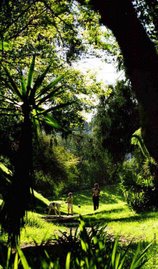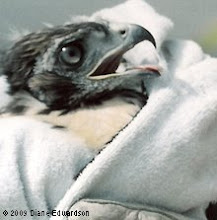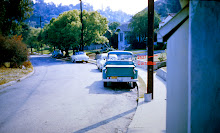 Photo: Diane Edwardson, March 4, 2010. Castor beans take over the lots adjacent to the Corralitas public staircase. (Click on photo to enlarge.)
Photo: Diane Edwardson, March 4, 2010. Castor beans take over the lots adjacent to the Corralitas public staircase. (Click on photo to enlarge.)Castor Beans (Ricinus communis) are non-native, invasive and on the UC Davis list as Class 1: "Major Toxicity" to to humans and animals. They also release a toxic gas when they burn. Castor Beans will quickly take over a hillside and return year after year. I've been on the Corralitas staircase in the summer, when the pods pop and launch their seeds a good 20 feet.
 Photo: Diane Edwardson, October 25, 2009. Castor Bean seedlings on the Corralitas public staircase. (Click on photo to enlarge.)
Photo: Diane Edwardson, October 25, 2009. Castor Bean seedlings on the Corralitas public staircase. (Click on photo to enlarge.)The following account is my own observation of eradication attempts on the Corralitas public staircase.
Seedlings sprout 10 days after rain. Within 2 - 3 days, they can reach a root length of 6 - 8" while the plant above ground is only 2 - 3". It's best to eradicate them by carefully pulling the entire seedling and either let it dry out on concrete or immediately dispose of the seedlings.
If the seedling breaks off at the root, it will grow back in a matter of days. If you toss the seedling onto dirt or grass, the root will grow into the soil and establish in the new location.
 Photo: Diane Edwardson, March 5, 2010. Dozens of Castor Bean seedlings are sprouting in patches on the Red Car Property. (Click on photo to enlarge.)
Photo: Diane Edwardson, March 5, 2010. Dozens of Castor Bean seedlings are sprouting in patches on the Red Car Property. (Click on photo to enlarge.)After the first few days, it's difficult if not impossible to pull the seedling by hand because the taproot grows so fast. Neighbors use shovels to dig out patches of hundred of seedlings at a time.
If the plants reach adult stage, you have to chop them down before they go to seed and remove the roots with a shovel. In the years when brush clearance was done prior to the Castor Beans going to seed, it was easier to eradicate the seedlings in the next rainy season, with fewer plants reached maturity. They will grow from seedlings to 12-feet tall in just one rainy season.


